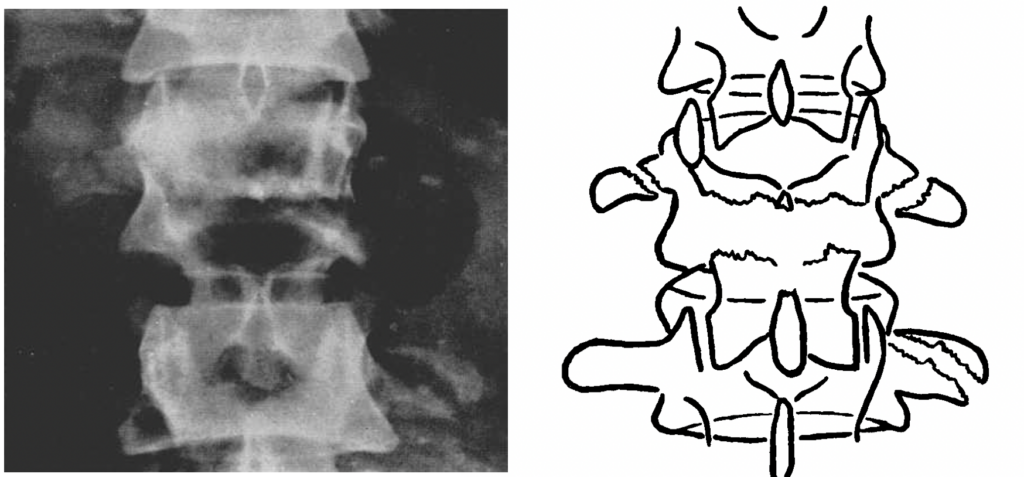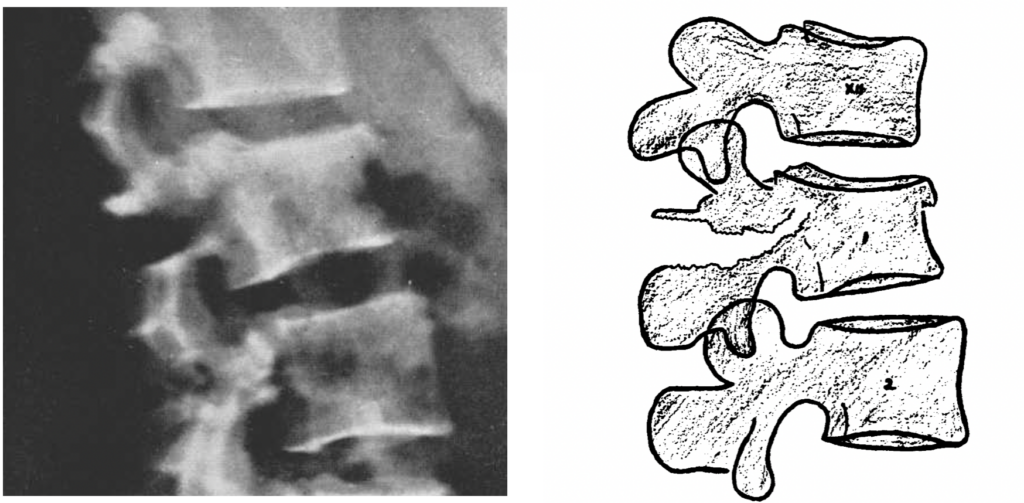George Chance
George James Quentin Chance (1904-1975) was an Irish radiologist
His name is immortalised in the “Chance fracture”—a flexion-distraction injury of the spine first described in 1948. His concise but landmark paper in the British Journal of Radiology introduced a previously unrecognised pattern of vertebral injury associated with seatbelt trauma, particularly in vehicular accidents, that would later gain importance with the rise of motor vehicle safety studies.
Born in South Dublin in 1904, Chance graduated from Trinity College Dublin with an MB BCh BAO in 1928. He held early house appointments in Worcester and Salford before pursuing radiological training at the University of Cambridge, where he received the DMRE in 1938. His postgraduate work brought him into contact with the Sheffield Radium Centre and laid the foundation for a career in diagnostic imaging.
In 1947, Chance was appointed Director of Diagnostic Radiology at the Derbyshire Royal Infirmary. There he played a central role in shaping radiological practice in the Midlands and mentoring a generation of radiologists. His professional affiliations included membership in the British Institute of Radiology and the Society of Fracture Radiologists. He was later elected an Honorary Fellow of the Royal College of Surgeons in Ireland.
Though his published output was modest, his clinical insights—particularly in the domain of spinal injury—proved highly influential. His 1948 description of the horizontal fracture extending through vertebral bodies and posterior elements laid the foundation for future spinal trauma classification systems, as later elaborated by Holdsworth, Denis, and Aebi.
Biographical Timeline
- 1904 – Born September 20 in South Dublin, Ireland.
- 1928 – Graduated MB BCh BAO from Trinity College Dublin.
- Late 1920s–1930s – Held house surgeon posts at Worcester General Infirmary and Salford Royal Hospital.
- 1938 – Obtained Diploma in Medical Radiology (DMRE) from the University of Cambridge.
- Late 1930s–early 1940s – Served as Senior Assistant Medical Officer at the Sheffield Radium Centre.
- 1943 – Co-authored article on air arthrography in the British Journal of Surgery.
- 1944 – Co-authored paper on causalgia in Journal of Neurology and Psychiatry.
- 1947 – Appointed Consultant Radiologist and Director of Diagnostic Radiology, Derbyshire Royal Infirmary, Derby.
- 1948 – Published landmark paper: “Note on a type of flexion fracture of the spine” in the British Journal of Radiology—now known as the Chance fracture.
- 1950s–1970s – Active contributor to professional radiological bodies
- 1965 – Retired from service in Derby.
- 1972 – Married in England to Alice E Carolan; registered as George J.Q. Chance.
- 1975 – Died May 17 at 43 Rue Victor Hugo, Tangier, Morocco.
Medical Eponyms
Chance fracture (1948)
The Chance fracture is a transverse fracture through a vertebral body and neural arch. These injuries typically occur at the thoracolumbar junction or in the upper lumbar spine. When the anterior ligaments are also injured, this injury may be a fracture-dislocation, carrying a higher incidence of neurological injury. With these fractures, one must always be alert to the high likelihood of injury to the bowel and other abdominal viscera.
in 1948, Chance published a Note on a type of Flexion Fracture of the Spine in the British Journal of Radiology. Initially he described a purely osseous injury in his case series of three patients.

The fracture which I illustrate is a true flexion fracture, though of a rarer type. It consists of a horizontal splitting of the spine and neural arch, ending in an upward curve which usually reaches the upper surface of the body just in front of the neural foramen.
In my three cases there has been very little wedging of the vertebral body, no dislocation of the apophyseal joints, nor has there been any cord damage…As there is no major ligamentous damage, the upper half of the fractured neural arch is firmly fixed to the normal arch of the vertebra above, and similarly the lower half is fixed to the vertebra below. The outline of these halves, in a horizontal plane, is therefore still undisturbed, so that a simple hyperextension of the spine must inevitably bring the two halves into perfect anatomical apposition, and give a near 100 per cent, prognosis.

Major Publications
- Cullen CH, Chance GQ. Air arthrography in lesions of the semilunar cartilages. Br J Surg. 1943; 30(119): 241-245.
- Chance GQ. Note on a type of flexion fracture of the spine. Br J Radiol. 1948; 21(249): 452.
- Doupe J, Cullen CH, Chance GQ. Post-traumatic pain and the causalgic syndrome. J Neurol Psychiatry. 1944; 7(1-2): 33–48.
References
Biography
- Derbyshire Royal Infirmary. Annual report and statement of accounts. 1947: 4
- Hunter TB, Peltier LF, Lund PJ. Radiologic History Exhibit Musculoskeletal Eponyms: Who Are Those Guys? Radiographics. 2000 May-Jun;20(3):819-36
Eponymous terms
- Kingsbury-Smith R. Chance and his fracture. Trauma. 2008; 10(1): 13-15.
- Nicoll EA. Fractures of the dorso-lumbar spine. J Bone Joint Surg Br. 1949; 31B(3): 376-94.
- Aebi M. Classification of thoracolumbar fractures and dislocations. Eur Spine J. 2010;19 Suppl 1 : S2-7
- Thakur JD et al. George Chance and Frank Holdsworth: Understanding Spinal Instability and the Evolution of Modern Spine Injury Classification Systems. Neurosurgery. 2020 Apr 16. pii: nyaa081. doi: 10.1093/neuros/nyaa081.
Eponym
the person behind the name
BA MA (Oxon) MBChB (Edin) FACEM FFSEM. Emergency physician, Sir Charles Gairdner Hospital. Passion for rugby; medical history; medical education; and asynchronous learning #FOAMed evangelist. Co-founder and CTO of Life in the Fast lane | On Call: Principles and Protocol 4e| Eponyms | Books |
